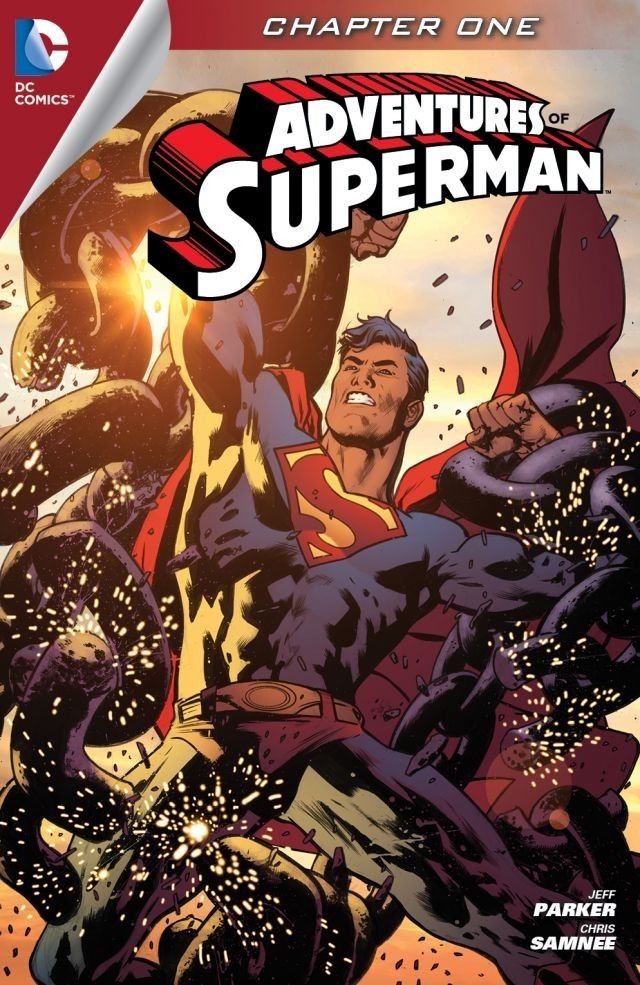DC Comics hasn't had a particularly good run of things lately. To be frank, the publisher has done blown it a number of times over the past few years. But don't worry, DC fans -- I'm sure it'll soon be Marvel's turn, as the two rivals seem to trade off every five years or so.
I've been calling out DC for the past couple of weeks, but that doesn't mean everything it does strikes me as wrong. It's important to declare shenanigans, but it's also important to recognize when a publisher does something that's good for comics.
So here are six things DC is doing right:
1. Digital comics: Legends of the Dark Knight and Adventures of Superman are digital-first anthology series that feature some excellent creators (from Jeff Parker and Chris Samnee to J.M. DeMatteis and Jeff Lemire) producing completely accessible and entertaining stories that stand on their own; no college course on the New 52 or Crisis on Infinite Earths required. Yes, these stories are out of continuity -- so for a percentage of readers, they don't count. That's a mistake, because there's nothing wrong with a straight-up superhero tale that exists on its own terms. These two anthologies are the gems of DC's digital-first line-up, but Batman '66 and Batman: Li'l Gotham also offer fantastical takes on the iconic Caped Crusader that are bright and fun. For those exhausted by the angsty versions of serious stories, you owe it to yourself to check these out.
2. Vertigo: After the twin blows of Karen Berger's exit and the kidnapping of the DC Universe characters, it seemed as if the producer of some of DC's most innovative comics might just fade away. Let it be known, however, that the reports of the death of Vertigo have been great exaggerated. Fables continues unabated, even blossoming into a full-on franchise with numerous spinoffs, including the current Fairest ongoing; not since The Sandman has Vertigo had such a long-running book with such an enthusiastic following. The Unwritten and American Vampires are the imprint's other dependable titles. Perhaps even more exciting are new and recent launches that show there's still plenty of life left in Vertigo: Jeff Lemire followed the post-apocalyptic Sweet Tooth with the experimental time-travel love story Trillium, and Batman writer Scott Snyder teamed with Punk Rock Jesus artist Sean Murphy to deliver ocean horror in the form of The Wake, while FBP: Federal Bureau of Physics (previously Collider), Coffin Hill and Hinterkind promise to be be interesting entries into genre storytelling. If it's superhero action you want, Vertigo has Kurt Busiek's Astro City. And let's not forget the October debut of The Sandman: Overture, guaranteed to be a huge seller and an intriguing trip back to the beginning.
3. We Can Be Heroes: DC's charitable campaign to fight the hunger crisis in the Horn of Africa is a testament to the good that DC, its iconic characters and loyal fans can accomplish. After an amazingly successful launch on Indiegogo that raised more than $150,000 and the Superman Edition follow-up that generated more than $130,000, the campaign is now in the midst of the Justice League Edition, final fundraiser for the year, with a goal of $125,000. To see comics do so much good makes me proud.
4. The bright spots in the New 52: There may not be a whole lot that aesthetically jumps out at me in the New 52 but there are some notable exceptions that not only catch my eye but seem to be doing the trick for a number of people. Most of these have to do with titles handled by creators with a more unique style or flair that helps it stand out from the sameness of the retro-'90s feel. J.H. Williams III's Batwoman has been a dazzling demonstration of ornate page design and layout (although he and co-writer W. Haden Blackman are leaving the title). Brian Azzarello and Cliff Chiang's Wonder Woman stubbornly refuses to simply reiterate previous takes on the character while presenting fantastic art. Scott Snyder and Greg Capullo have confidently their marks on Batman. There are a few others, too, and a lot of these books largely exist with minimal or no crossovers or other interference from the rest of the shared universe, save for the occasional stunt like the current Villains Month.
5. MAD Magazine: If you like your comics with uninterrupted numbering, here's one of your last bastions in North America. The 523rd issue of MAD Magazine was released last month, and there's no relaunch in sight. OK, technically it's a magazine and not a straight-up comic book, but why split hairs? Every issue still has crazy cartoons in the margins by Sergio Aragonés. Every issue still lampoons pop culture. Every issue will still make your junior-high self giggle uncontrollably. That doesn't mean old Mr. Neuman is stagnant; MAD's blog and Facebook page have proved to be surprisingly fresh and relevant. They post meme-ready graphics cranked out as current events break. With nearly 100,000 likes on Facebook, images regularly get shared a couple of hundred times, proving that this old institution can still strike a contemporary chord.
6. Comics/video games synergy: This is a little outside my wheelhouse, but I saw people flip out about Batman: Arkham Asylum and be generally very happy with the sequel Batman: Arkham City; another sequel, Arkham Origins, is to be released next month. Injustice: Gods Among Us is also well-liked, and the accompanying digital-first comic appears to be one of DC's bestselling digital comics. The Batman games also got digital-first comics, but the Injustice one seems to have really taken off. It's a smart approach. Video game players are probably online more, put the crossover content where they're apt to find it. It looks like one of those stupidly simple moves in retrospect but it's the kind of move that considers what is most intuitive for potential readers, and it's a move that appears to have produced a very lucrative hit.


